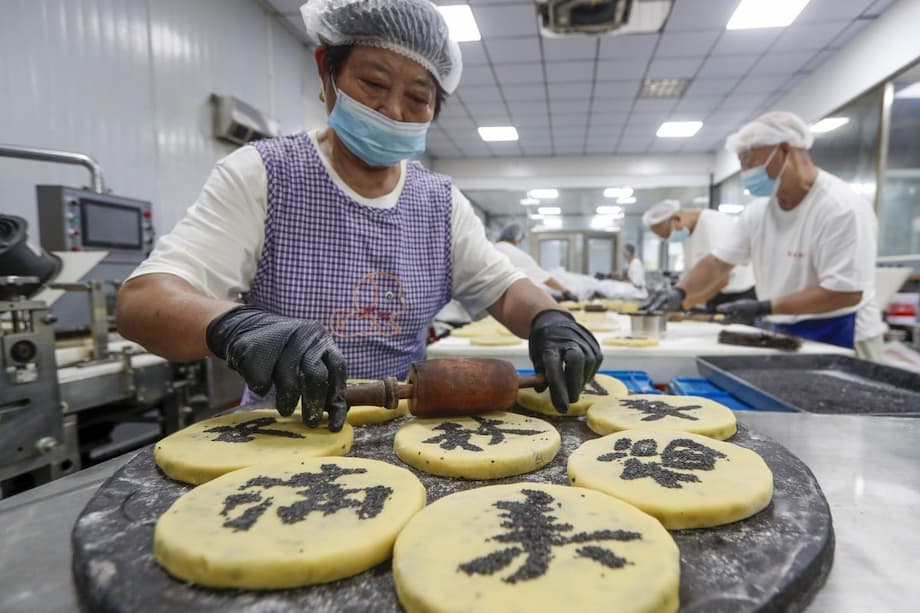A softer Mid Autumn for China’s gift economy
Mooncakes, the dense pastries that symbolize reunion during the Mid Autumn Festival, are selling more slowly in China this year. Retailers and corporate buyers report tighter budgets and smaller orders compared with past seasons. The holiday is still one of the most sentimental moments on the calendar, yet the appetite for premium gift boxes has cooled. The shift points to a broader reality in the economy. Households remain cautious, companies are trimming costs, and gift giving has become more practical and price sensitive. The softness comes even with an unusually long holiday this year. The festival on October 6 coincides with National Day, creating an eight day break that typically encourages leisure spending. Many shoppers are still choosing value over showpiece gifting.
- A softer Mid Autumn for China’s gift economy
- Why budgets are shrinking this year
- Corporate gifting cools after years of crackdowns and new rules
- From luxury to value, the changing mooncake market
- Travel, experiences, and the super golden week effect
- What is a mooncake and why it matters
- Global appetite remains strong
- Health, safety, and regulation concerns
- Voices from the market
- What it means for brands and retailers
- Key Points
In past cycles, luxury mooncake sets with ornate packaging signaled status and generosity. This season, more buyers are trading down to simpler assortments, smaller box counts, and lower sugar variants. Retailers describe a calmer pre festival rush, fewer corporate bulk orders, and a pivot toward modest bundles that do not stretch budgets. The temperature of the gift economy is cooler, and mooncakes, a classic discretionary purchase, are feeling that chill first.
Why budgets are shrinking this year
Consumers in China have been increasingly value oriented through 2025. A prolonged property slump has weighed on household wealth, while parts of the job market remain uneven. In this environment, the calculus for holiday spending changes. Families still gather, and people still exchange gifts, yet the scale of those gifts is more restrained. Even buyers who keep the tradition alive often choose less expensive items, simpler packaging, or discounts through group buy channels and community commerce platforms. The cultural impulse to give remains. The price tag attached to that impulse has edged down.
Companies are making similar trade offs. Corporate gifting is a long standing part of Mid Autumn customs, covering employees, clients, and partners. This year, many firms are under cost pressure, so procurement teams are revisiting how much they spend per person and how many recipients they include. Some have swapped premium pastry assortments for more practical care packs, or offered e gift cards that let recipients choose their own treats. Others keep mooncakes but cut the quantity per box or choose lower price tiers.
Household budgets are also stretched by other priorities. More families are spending on travel and activities during the extended break, and those expenses can displace traditional gifting. The result is a shift within the same holiday window. Experience based spending rises, while purchases of high end, non essential goods soften.
Corporate gifting cools after years of crackdowns and new rules
Another force behind calmer demand is a multi year push against lavish gifting and wasteful packaging. Regulators have imposed rules that discourage extravagance, including limits on excessive packaging and tighter oversight of deluxe sets sold through hotels and prestige venues. Companies have adjusted to these standards, while also seeking to avoid any perception of inappropriate gifting. The broader effect has been to tilt the market away from ostentation and toward restrained, arguably more authentic products.
Packaging is now simpler, lighter, and often made with recyclable materials. Buyers complain less about boxes that look beautiful yet are cumbersome to carry and hard to reuse. The old impulse to impress with ornate tins and heavy wooden chests has lost momentum. When budgets tighten and scrutiny rises, substance matters more than packaging. That trend naturally favors mainstream price points and classic recipes.
From luxury to value, the changing mooncake market
The mooncake aisle now spans everything from truffle infused custards to plain lotus paste, from lavish gift chests to small combination sets. This year, sales are tilting toward the middle and lower ends. Retailers report stronger interest in compact assortments, low sugar recipes, and gift boxes that bundle a few traditional cakes with lighter pastries. New flavor lines still exist, and novelty still catches attention, yet many shoppers compare prices more carefully and skip the most expensive creations.
One visible casualty is the ultra premium segment. Ice cream mooncakes, once a sensation of the luxury gifting wave, have faced stiff headwinds. Price sensitive buyers view them as a novelty rather than a must buy. Some distributors describe steep drops in these orders compared with previous years. Traditional baked styles, by contrast, remain the dependable core, especially in smaller formats that fit modest budgets.
Bakeries that span Chinese, Taiwanese, and Southeast Asian traditions have responded with variety and restraint. Many now offer flexible sets that mix large and small cakes, or bundle classics with a few modern additions like lava custard. Low sugar lines, tea focused assortments, and compact seasonal pastries give shoppers more ways to keep the tradition without overspending.
Travel, experiences, and the super golden week effect
This year’s calendar created an eight day holiday that includes both National Day and the Mid Autumn Festival. That is a boost for travel and dining, two categories that capture a growing share of discretionary yuan. Families that might once have devoted a large budget to gift boxes are booking trains, flights, and hotels, or organizing multi generational meals at restaurants. The memory of a shared trip or a lantern walk can feel more rewarding than a showy pastry box that sits on a shelf.
Events and public celebrations add to that shift. Lantern fairs, neighborhood light ups, and moon viewing parties draw crowds who spend on food stalls and small treats rather than high end gifts. Shopping centers run promotions around festival themes, often combining discounts with entertainment. The experience economy has become a bigger part of the holiday mix, and mooncake purchases reflect that balance.
Restaurants and cafes have learned to weave mooncakes into dining packages, offering a simple box with a set meal, or a complimentary pastry with reservation deposits. The packaging is lighter and the focus is on the meal itself. For many households, that pairing of tradition and experience feels more aligned with current priorities.
What is a mooncake and why it matters
Mooncakes are rich pastries traditionally shared with family and friends on the night of the full harvest moon. The cake’s round shape represents unity and completeness. Many include salted duck egg yolks, whose golden cores evoke the moon. The ritual is simple and deeply rooted. Swap a box with loved ones, slice and share, then admire the moon together. That action links generations and regions, from the Pearl River Delta to the Yangtze basin, across northern cities, and throughout the Chinese diaspora.
Common fillings and styles
Classic Cantonese style mooncakes use lotus seed paste or red bean paste, sometimes with single, double, or even more egg yolks inside. Mixed nuts and ham is another heritage filling. Suzhou and Shanghai styles lean on flaky pastry and can be sweet or savory. Taiwanese bakeries often sell pastries with mung bean paste and flaky crusts that sit alongside mooncakes during the season. Pork floss, jujube dates, black sesame, and matcha have long had followings. Each region carries its own texture and sweetness preferences, which is why variety boxes have become popular with both gift givers and first time tasters.
New school creations
Modern bakers refresh the category every year. Custard filled mooncakes, sometimes with flowing centers, have a strong fan base among younger customers. Snow skin versions, with a soft mochi like exterior, provide a chilled and lighter alternative to the classic baked crust. Bakers now experiment with tea based creams, tropical fruits, and layered fillings that add contrast. Many offer low sugar or low oil recipes to address health concerns. The most successful innovations respect texture and balance, the qualities that let a small slice feel satisfying rather than heavy.
Global appetite remains strong
While mainland buyers are tightening belts, the festival’s reach across the diaspora is wide and lively. In Sydney, Chinatown merchants build the largest mooncake selection in Australia, with rows of traditional lotus and red bean alongside lava custard and espresso green tea twists. A second generation shop owner, Daniel Trinh of Thai Kee, spends weeks tasting brands and curating flavors that appeal to both long time patrons and curious newcomers.
Daniel Trinh, a second generation owner at Thai Kee in Sydney Chinatown, said: “What makes a good mooncake? One that is visually exciting and interesting taste wise. Lotus is still the most popular flavor, and it is the one I recommend to first time mooncake eaters. Younger customers also seek playful fillings like lava custard that they can share with friends.”
In New York City, cultural institutions, tea houses, and community groups host workshops, tea tastings, and family festivals. Lantern making, shadow puppetry, and mooncake baking classes bring the tradition into classrooms and galleries. Across Los Angeles, bakeries from long standing Chinatown shops to modern Taiwanese patisseries sell both classic and snow skin styles. Some places now keep mooncakes on offer year round, a sign that curiosity and demand in diaspora communities continue beyond the holiday window.
Singapore shopping centers mount mooncake fairs with dozens of brands, from traditional bakers to coffee chains selling new flavors. Promotions often bundle mooncakes with tea sets or small keepsakes, a practical twist that still honors gift giving. Southeast Asian flavors such as durian snow skin ride a distinct regional wave, while low sugar and petite sizes mirror the global swing toward moderation.
Health, safety, and regulation concerns
Holiday foods come with safety watch points. Authorities in Taiwan, one of the few places in Asia free of major swine diseases, warn travelers against bringing in pork products around Mid Autumn. Some festival pastries include meat fillings, which can trigger fines and strict confiscation at the border. The caution reflects a broader regional concern about animal disease control and food safety during peak gifting periods. Strong rules and testing regimes have become part of the seasonal landscape.
Environmental concerns also steer buyers. The drive to reduce packaging waste has pushed brands to slim boxes and use recyclable materials. That aligns with both regulation and consumer sentiment. Shoppers increasingly prefer a clean, compact design that stores easily and leaves a smaller footprint after the holiday.
Voices from the market
Grace Qiu, an administrative manager at a corporate consulting firm in Guangzhou, has watched the shift up close. Her company values Mid Autumn benefits, yet this year the gift budget is far smaller and the corporate outlook more cautious.
Grace Qiu, administrative manager at a Guangzhou corporate consulting firm, said: “This year’s per person budget is only 140 yuan, a 40 percent drop from last year, even though Mid Autumn gifts are one of our most important employee benefits. The industry is extremely sluggish. We lost our biggest client and then had to lay off a third of our staff since the start of the year.”
Her comments echo the micro level story behind national headlines. When a company cuts back, it buys fewer premium boxes, shifts to smaller sets, or pauses gifting for some teams. Those choices ripple through distributors, bakeries, printers, and logistics providers. For many small and mid sized vendors, the festival is a crucial revenue window. A single weaker season can sting, and a second one forces hard decisions about product lines and inventory.
What it means for brands and retailers
Winning this season looks different than in the high gloss years. Brands that keep base prices accessible and focus on taste, texture, and freshness have an advantage. Value is the headline. That does not rule out creativity. It simply asks for it at a reachable price point. A small box with two classics and one modern flavor often lands better than a large chest filled with novelties. Limited designs that double as home storage are appealing when they are light and reusable, not bulky display pieces.
Digital channels matter. Corporate buyers and families alike are using mini programs and social commerce to compare sets, order ahead, and coordinate deliveries to far flung relatives. Gift codes and e vouchers give senders flexibility when address details are uncertain. Clear delivery windows and temperature control are vital for custard and snow skin products. Service reliability is a point of differentiation as much as flavor.
Retailers can pair mooncakes with tea, coffee, or small bites to create affordable bundles, host tasting counters to help first time buyers choose flavors, and run early order perks that spread demand across weeks rather than days. A cautious consumer still spends for meaning and quality. The job for brands is to honor the tradition at a price and format that fits 2025 budgets.
Key Points
- Early season mooncake sales in China are weaker than in prior years as households and companies cut non essential spending.
- Corporate gifting is more restrained, with many buyers shifting to smaller sets, simpler packaging, and lower price tiers.
- Regulatory pressure against lavish gifting and excessive packaging has pushed the market toward practical, recyclable designs.
- The eight day holiday boosts travel and dining, which draws spending away from premium gift boxes.
- Classic baked mooncakes in modest assortments are holding up better than ultra premium items such as ice cream mooncakes.
- Global demand is lively across diaspora communities, with strong interest in traditional and modern styles in cities like Sydney, New York, and Los Angeles.
- Food safety and import rules, especially around meat filled pastries, are in sharper focus during the festival window.
- Brands that emphasize taste, freshness, service reliability, and accessible pricing are better positioned in a cautious 2025 marketplace.












